FIROZ SHAH TUGHLAQ….”THE PRINCE OF BUILDERS”
Firoz Shah, to whom was bequeathed a depleted empire, must have had to make heroic efforts indeed to fulfill his divine duties. His humble desire was to erect public buildings.One may well take with a massive pinch of salt the claim of contemporary historians that he made 1200 garden around Delhi and is credited with the erection of 200 towns,40 mosque,30 villages,30 reserviors,50 dams,100 hospitals,100 public baths and 150 bridges, nevertheless judging from the extant remain there is little doubt the Firos Shah building were indeed extensive even though spartan in appearance.
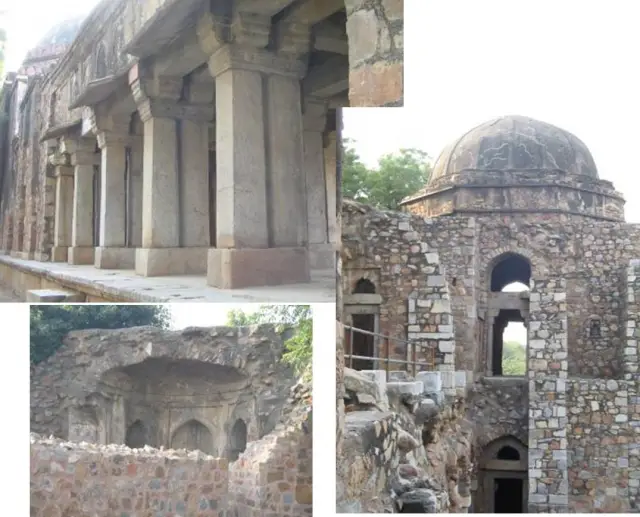
The architecture of Firoz Shah is stern, utilitarian, almost tragic – at times hauntingly lovely (Hauz Khas Madrasa by night), at times warningly forbidding. This is due in no small measure to its rough exposed finish (the glazed tiles having come off a long time ago) as well as the lack of skilled masons and sufficient capital.
FIROZABAD…….”THE FORTRESS CITY”
Erected in 1354 by Emperor Firuz Shah Tughluq on the western banks of the Yamuna River in the fifth city of Delhi, Ferozabad, the Kotla of Firoz Shah became a sixteenth-century prototype of Mughal city palace architecture. Conforming to an irregular rectangle plan of 2,624′-6″ (800m) x 1,312′(400 m) its longer side follows the north-south axis. The entire formation is encased in high solidly fortified walls composed of stones. Most of the complex’s structures are in a state of ruin offering fragmented evidence of the original design.
The citadel of Kotal had three splendid palaces, a large and grand mosque, reception halls, galleries, gardens, a baoli and a unique pyramidal structure to uphold the Ashokan pillar he had brought from Ambala. Most of these buildings are rubble work covered with heavy plaster without any surface decoration. The masonry lacked the strength and finish of the architecture of the preceding period.., known structures.
The citadel of Kotal had three splendid palaces, a large and grand mosque, reception halls, galleries, gardens, a baoli and a unique pyramidal structure to uphold the Ashokan pillar he had brought from Ambala. Most of these buildings are rubble work covered with heavy plaster without any surface decoration. The masonry lacked the strength and finish of the architecture of the preceding period.., known structures.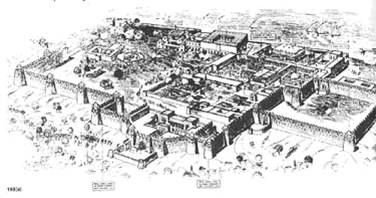
The fort itself was fairly straightforward, using common-sense building principles used the world over for buildings of a similar type.
…..PLANNING OF CITADEL
The Tughlaqabad area was woefully short of water and this made the Tomars move westward to Mehrauli. Firoz Shah, Muhammad Tughlaq successor solved this problem by building his new city on the banks of Yamuna. Kotla was the inner citadel of Firozabad, built like Windsor, with great palaces and a magnificent mosque inspiring Timur envy. Destroyed by the Mughals, Kotla palaces were reduced to mere ruins, exposing to view the subterranean passages and covered cloisters. One can still see the pyramidal structure topped by the Ashokan Pillar brought from Topra, and a three tiered baoli. Timur invasion of Delhi reduced the city to a city of ruins as he took away with him elephants loaded with treasures and costly building material. The Saiyyads and Lodis used Kotla as their citadel.
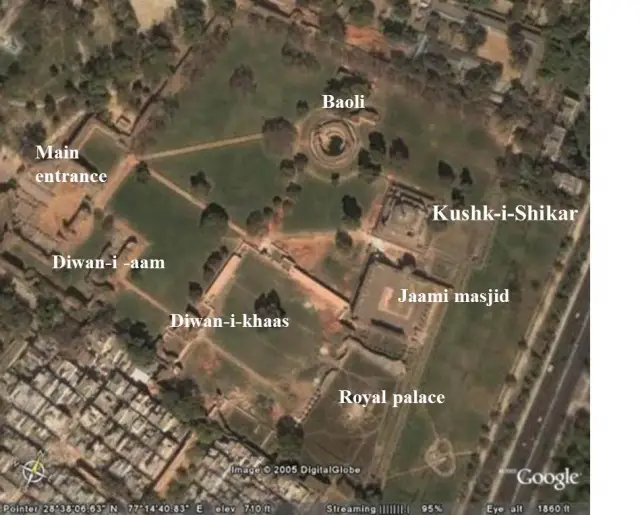
Present View of the citadel of Kotla
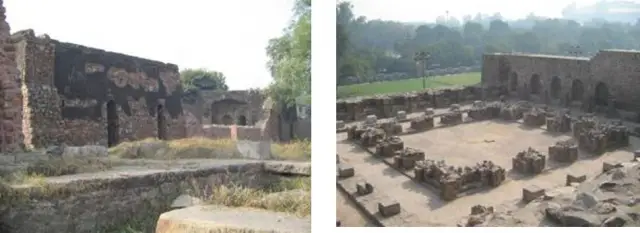
The broad planning principles of a ‘Muslim city centre’ enunciated for the first time by Firoz Shah consisted in locating the Diwan-i-Khas at the heart of the complex, backed up by a series of private palaces along the riverfront, well-protected on the other side by army barracks and other sundry structures, with limited access for the common public to the Diwan-i-Am.
…..THE TALE OF THE RUINED CITADEL
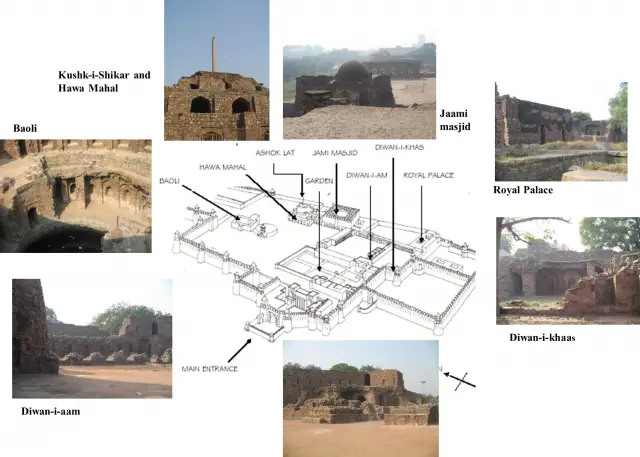
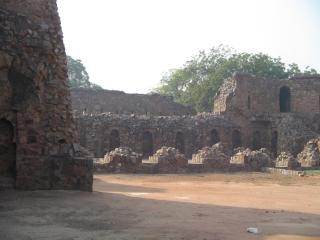
The central entrance on the west side is a fortified gate with barbican towers on the approach and is protected by a curtain wall with the guard’s quarters and soldier’s barracks in the inner courtyard. Inside the gate a huge rectangular courtyard surrounded by a pillared verandah, that was the Mahall-i Bari Amm or Palace of the Public Court, was used for public receptions and was also called the Central Quadrangle. Immediately behind this space is a square pillared hall similar to the Diwan-i-Khass, a private hall for the king to receive his counselors and chief administrators.
The northern part of the Kotla still has a baoli (a deep well surrounded by underground rooms) where the atmosphere is fresh even on the hottest day of summer. The three-tiered structure of a small and functional baoli is near intact. The water supply runs through transverse pipelines And cistern provisions, harnessing to advantage its prorjmitv to the river which then flowed below the ramparts. During the summer months the baoli functioned as a cool retreat for the royal inmates of the palace.
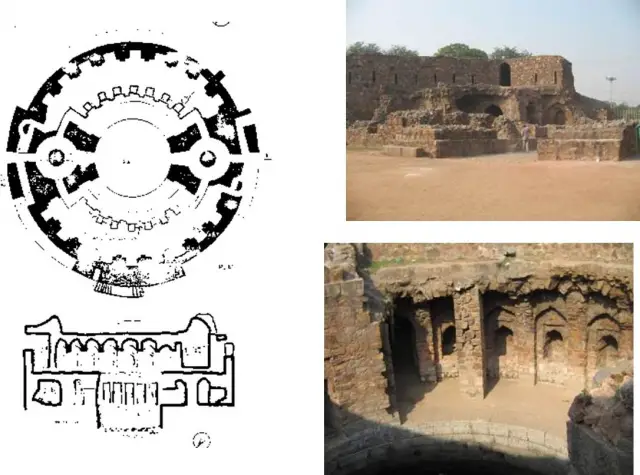
Remains of Kushk-i-Shikar, which contains one of the pillars of Ashoka.
The Hawa Mahall still stands in the form of a stepped pyramid with diminishing floors, which are linked with private rooms via a secret corridor in the western wall of the Jami masjid, now for the most part in ruins. The triple-storeyed construction to vaulted cell around r solid core with stairs at the comers leading to the uppermost terrace where the Ashokan pillar is planted.
The Hawa Mahall served as a prototype for sixteenth century Mughal city palaces and the narrow connecting corridor behind the qibla wall became a common feature of mosques built later on in the sultanate. The Hawa Mahall is also known as the Lat (pillar) Pyramid because Firuz Shah mounted one of the pillars (lat) of Ashoka atop the palace.
The inspiration for the building could have been the numerous Buddhist ‘viharas’ that abound in the Indian countryside
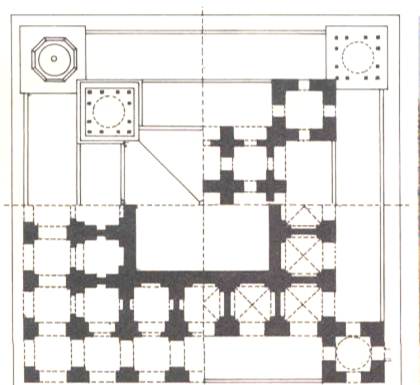
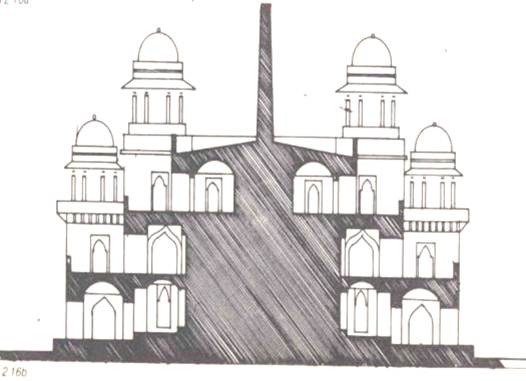
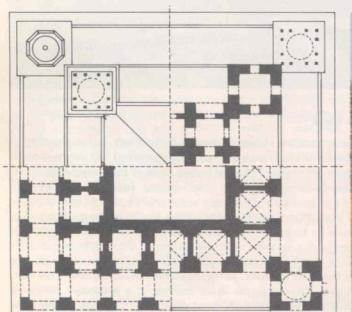
The Jami Masjid at Kotla has survived in its open spectacular courtyard and a portion of the western wall. Raised on a terrace of vaulted chambers, the mosque could accommodate nearly tenthous and men at prayer. According to Franklin who visited the mosque m 1793, it had four cloisters, the domed roofs of which were supported by 260 stone columns, each about 5m high. The centre of the courtyard lay under an 8m high brick and stone octagonal dome. On the central column Firoz Shah is believed to have inscribed his great achievements, the place now indicated only by the pit at the centre.
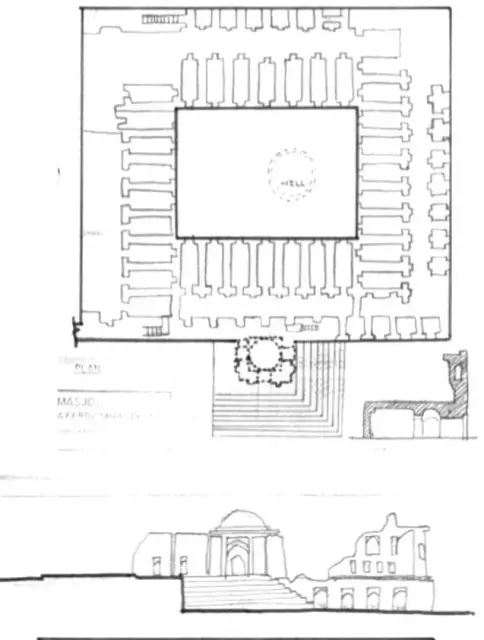

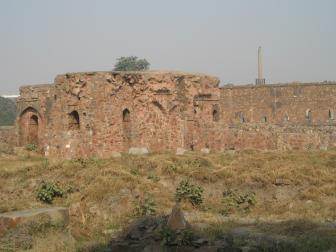
The king’s quarters as well as those of his wives, harems and mosques along the riverbank to the north and south are divided into various rectangular and square courts. In each there were different activities: ‘such as pavilions of differing uses, tree-lined gardens with water, baths, fountains, barracks, armories and the servants’ quarters, all arranged so as to be connecting.’ Descriptive accounts mention mirrored halls, as well as sandalwood sculptures and figural and landscape murals.
….FIRUZ SHAH AND HAUZ KHAS
Madarsa… the institution
Education was closely connected with worship and from the beginning mosques could be used for both prayer and instruction. The two functions eventually diverged, however, and the result was the collegiate mosque or madarsa.
Differing from the mosque in nature, object and history, the madarsa is also distinct from it in its architectural features. This college or madarsa was built by Firuz Shah in the year 1352-53 AD on the south and east banks of Hauz- Khas
The madarsa and associated buildings are on an ‘L’ shaped plan. It extended over a large area consisting of a two storeyed series of interconnecting blocks of long narrow pillared halls and domed chambers.
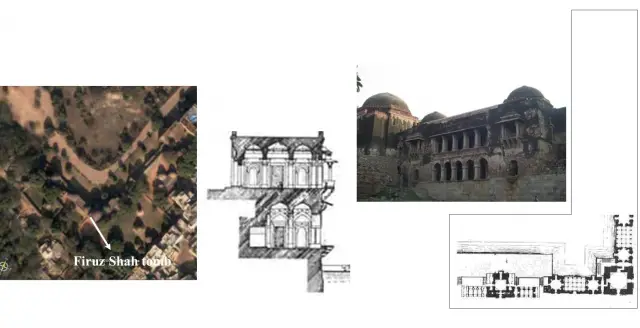
The lower storey has cells which were used most probably for residential purpose, the upper storey, more open to breezes from the water, seems to have served instructional purposes. It is also level with the spacious and carefully planted gardens located to the south and east between the madarsa and the outer walls of the complex. With their lattice windows medallions in stucco, lotus motif, paintings on ceilings, balconied windows and deep niches.
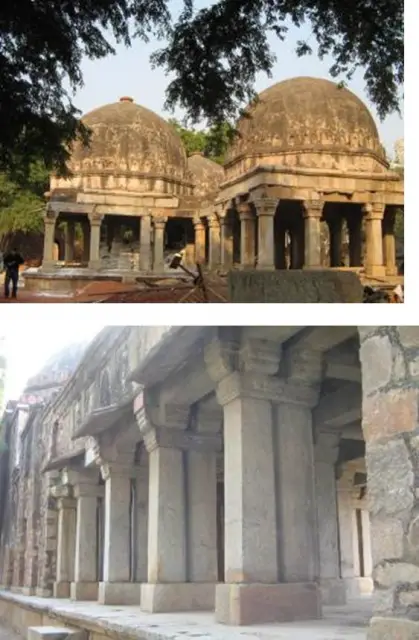
At the intersection of the southern and eastern blocks was the square domed tomb of Firuz Shah, in the garden to the east are, several domed pavilions and domed pavilion tombs some polygonal and some square in form.
To the north of these chhatris is situated a grand complex of pillared pavilions .The whole has been so planned with the help of three square and domed pavilions, all connected with a set of colonnades, as to serve the purpose of a great assembly hall. Except for the external plaster surface of the three domes which were, as it seems, originally glazed tiled, the entire construction (steps, plinth square pillars, capitals and corbelled courses of ceilings) is in local stone. Massive high domes have been used to give this complex an effect of grandeur crowned by Kalasa finials
The whole is open on all sides giving a pleasing prospect of the vast lake of Hauz Khas from below the adjoining terrace. The construction is with local grey stone or quartzose forming pillars and lintels on the one hand and rubble and plaster work on the other. Both trabeate and arcuate methods have been used together for spanning the space.
….JAMI MASJID, HAUZ KHAS
It is located at the northern, end of the complex and consists of a prayer hall 81′-3″x12′-7″, nine bays wide and a single bay deep; arcades on the north and south sides, each two bays deep and four bays long, partially-frame the broad, T -shaped court on the east. The five arched facade of the was protected above by a chhajja.
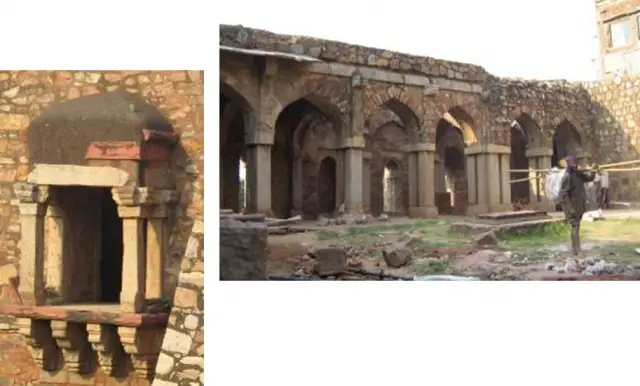
Square stone pillars have been used to support the arches and the inner , bays which had domes supported on vaults at the corners. Double pillars used at all vulnerable points (corners), but they had a monolithic base and also a single capital. This is typical of the art of India. The most interesting is the fact that these simpler pillars are supporting the arches as efficiently as they would have supported the lintels, architraves or corbelled ceilings. Some 19′ (5.79 m) to the east of the south wing is a domed structure which was apparently the gateway.

…..FIRUZ SHAH TOMB
Firuz Shah chose the square plan, for his own tomb in the Hauz Khas Madarsa. The tomb is a beautifully proportioned 45′ (13.7 m.) square structure, built in the characteristic ascetic style of the tughluqs. In general plan, it is strongly reminiscent of the lal Gumbad and the tomb of Ghiyathu’d-Din.
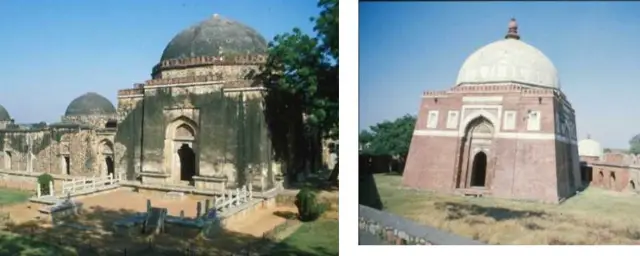
Tomb of Ghiyathu’d-Din
The familiar rubble masonry walls are finished with a thick layer of lime plaster punctured with arch and lintel openings, the whole crowned with a parapet of merlons. The walls with slight batter ornamented by battlements of the drum from which the dome springs. Contiguous with the tomb at its north and west wings are the buildings of madarsa, while its east and south facades are open to view.
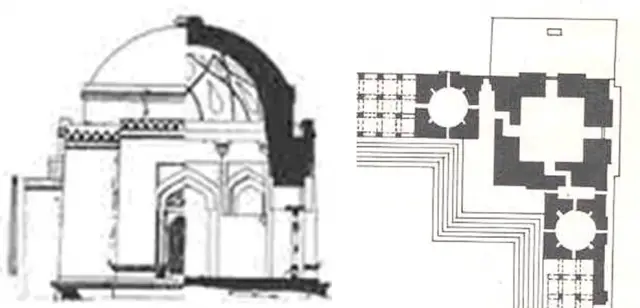
It is entered 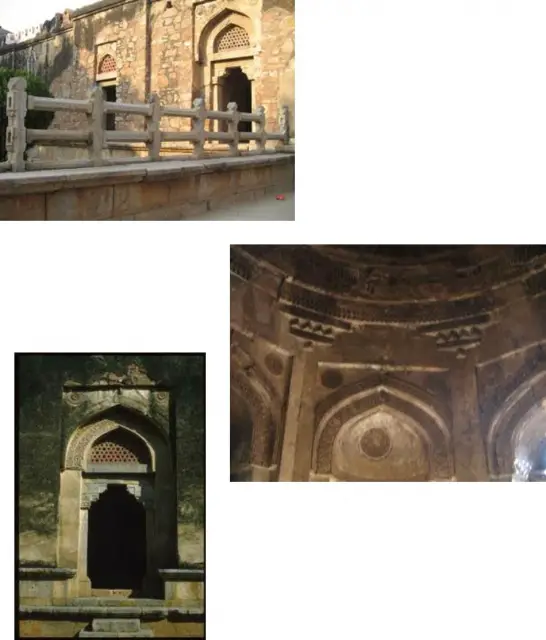 from the garden to the south means of a paved verandah enclosed by stone railings plainly derived from Buddhist prototype. Above the parapet incised with ornamental merlons rises an octagonal drum supporting a shallow and slightly pointed dome. Internally the tomb measures 28′-7″ (8.74 m.) and is paved with grey stone slabs. At the drum level the square merges into an octagon by deeply recessed arched pendentive and hence into the circular outline of the dome. The intrados and ceiling of the dome is embellished with coloured bands intersecting each other and squinch-pendentives are decorated with plaster-work, including incised calligraphy. Squinches have been used in the phase of transition.
from the garden to the south means of a paved verandah enclosed by stone railings plainly derived from Buddhist prototype. Above the parapet incised with ornamental merlons rises an octagonal drum supporting a shallow and slightly pointed dome. Internally the tomb measures 28′-7″ (8.74 m.) and is paved with grey stone slabs. At the drum level the square merges into an octagon by deeply recessed arched pendentive and hence into the circular outline of the dome. The intrados and ceiling of the dome is embellished with coloured bands intersecting each other and squinch-pendentives are decorated with plaster-work, including incised calligraphy. Squinches have been used in the phase of transition.
……TOMB OF KHAN-I-JAHAN TILANGANI
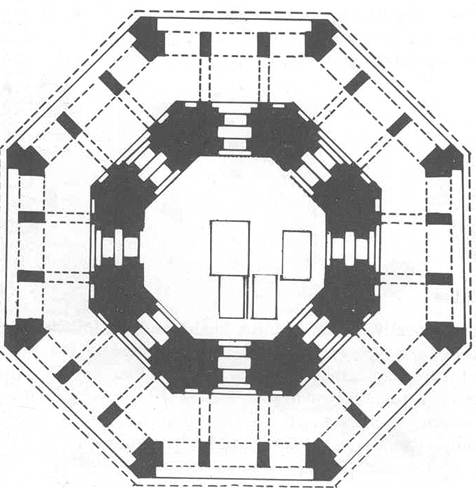
In the north-western of the Nizamuddin village area stands the tomb of khan -i-Jahan Tilangani, the prime minister of Firuz Shah Tuhluq. This tomb marks an entirely new departure. Instead of being square, like all other earlier tombs at Delhi, the octagonal tomb was built for the first time at delhi in 1368 AD. The builders may have been inspired by the octagonal plan of the sacred mosque of Oman in Jerusalem with a verandah on all its eight sides Slightly less than six meters on a side and about fifteen meters in diameter, the mausoleum consists of an eight-sided domed chamber of crude masonry and a blocky mihrab, it has three pointed arches on each of its octagonal sides protected above by chajja supported on bracket-stones. The use of the typical Hindu chhaijas added new dimension to the otherwise plain surfaces of Islamic (Turkish) architecture in India. Its stuccoed exterior has the pronounced Tughluq slope and was once enriched by an elaborate decorative and epigraphic programme.
Another innovation was the imposition of a range of eight cupolas or Kiosks roof rising above the embrasures of the parapet, one over each side. From this comparatively small beginning were, developed those large and stately mausoleums of octagonal conformation which imparted such distinctive character to the subsequent architecture of northern India.
Finally a number of Tughluq tombs belong to a type that can be categorized ;as chatri, or pavilion tombs. In most instances, the spaces between the piers were originally cleared by elaborately carved stone screens. This type also represents Tughluq innouation that was widely used in the gardens of the Hauz Khas madarsa of Firuz Shah.
Tughluq tombs, like Tughluq mosques show great variety in plan, and during this period of innovation and experimentation models were established that came basic for most subsequent Muslim architecture in India.
..…KHIRKI MASJID
This double storeyed mosque lies on the southern periphery of the village Khirki. Its plan is exactly against the plan of the Kalan Masjid which is rectangular. This has facilitated a geometrical division of the whole layout into four equal square quarters, having four square courts. Resting on a three metre high plinth the mosque is measuring fifty-two metres on side.
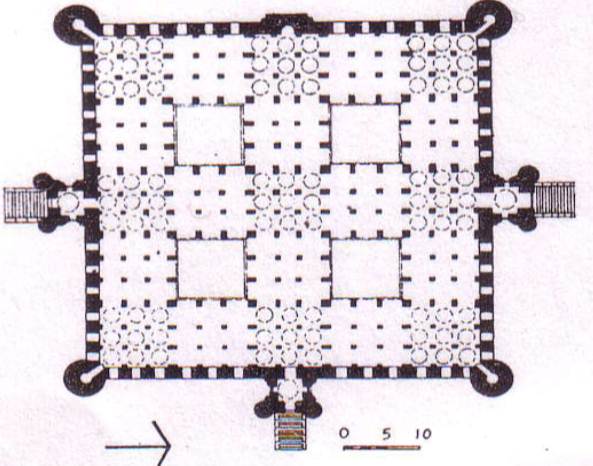
Battered bastions occupy its four corners some 45′ (13.71 M) in height imparting it the look of a fortified building. On the north, south and east are projecting domed gateways flanked by tapering minarets, while on the west is the central mihrab. The east gateway is the chief entrance to the building. It projects 23′ (7 M) and contains in the side wall two staircases giving access to the roof. The north and south gates as also the central mihrab chamber project 18′ (5.48 M).
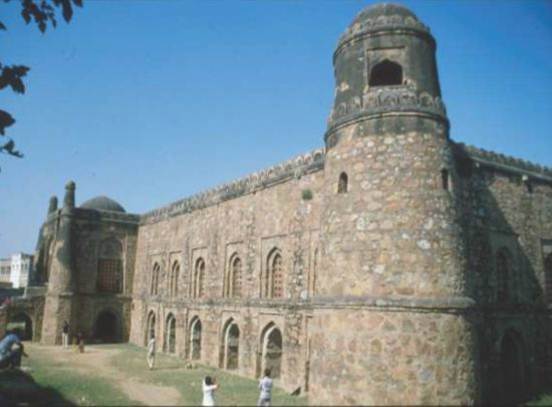
The whole interior has been divided into four square bays, supported on double stone pillars, and each one having an open court 30′ (9.14 M) in its centre: Cloisters run through all along the sides and also bifurcate in the middle of the mosque. It would be seen that out of 25 divisions of the terrace, four in the middle are open through courts, 12 have flat roofs and 9 have cupolas roofs nine in one set there being 81 copulas in nine sets on the superstructure .
The lower storey or `Tahkhana’ or substructure of arches which contains over 100 vaulted cells. The upper storey contains pointed arched windows (khirkis) with perforated screens
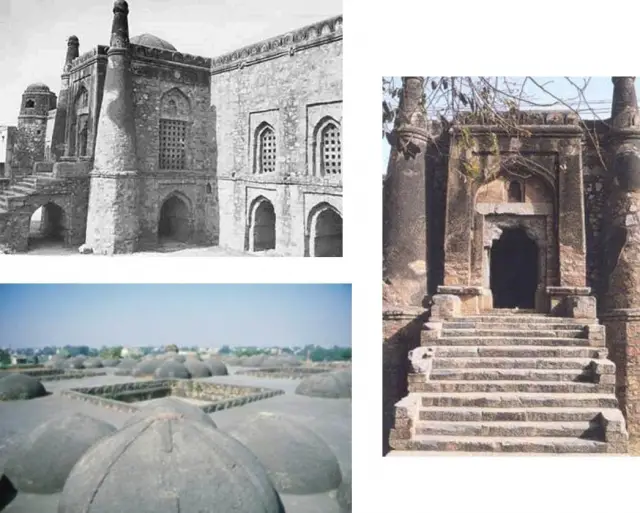
The north, south 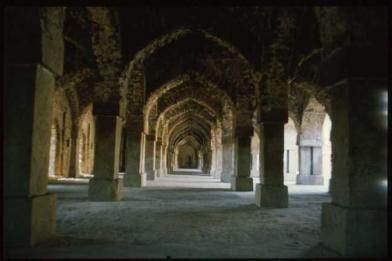 and east walls are pierced by windows closed by red sandstone grills which are repeated in the side walls of the gales and the mihrab chamber. The west wall contains 15 plain mihrabs or prayer niches 7 on each side of the central mihrab In planning, a part of the sahan was covered by a combination of a domed and flat roof and leaving four symmetrically arranged open courtyards for light and ventilation.. And so this experiment was repeated only once again at Gulbarga in the south
and east walls are pierced by windows closed by red sandstone grills which are repeated in the side walls of the gales and the mihrab chamber. The west wall contains 15 plain mihrabs or prayer niches 7 on each side of the central mihrab In planning, a part of the sahan was covered by a combination of a domed and flat roof and leaving four symmetrically arranged open courtyards for light and ventilation.. And so this experiment was repeated only once again at Gulbarga in the south
…KHIRKI MASJID A CLOSER LOOK
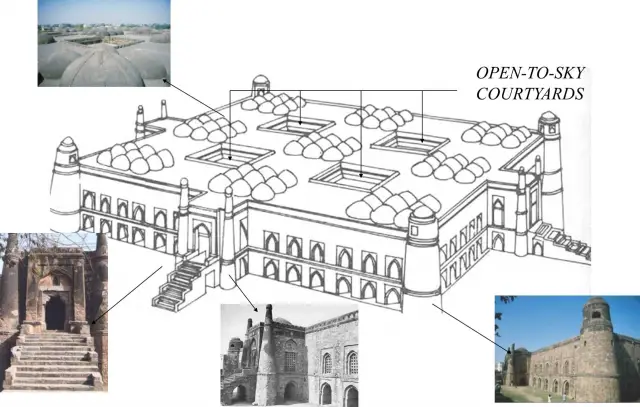
….KALAN MASJID, NIZAMUDDIN
On the eastern periphe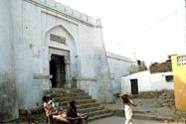 ry of the village of Nizamu’d-Din, lies Kali or Kalan masjid.It is built of rubble stone covered with plaster. Measuring 27 metres on a side its gateways are square, domed flanked
ry of the village of Nizamu’d-Din, lies Kali or Kalan masjid.It is built of rubble stone covered with plaster. Measuring 27 metres on a side its gateways are square, domed flanked
This masjid is very similar to the Khirki mosque, having a similar cruciform plan but it loses out upon the elegance which the former owing to its 25 equal harmonious units
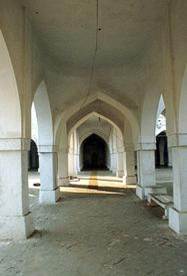
The corridors and the side cloisters are one aisle deep formed to pointed arches, which are supported on double stone being four at the corners, the whole being divided into square bays each one independently by a cupola on the chahartaq system. It is rectangular in plan and has four rectangular inner courts . The arcade around the interior is eleven bays on a side and only one bay deep, the prayer hall is three bays deep, and has an identical arrangement of square bays covered by cupolas.
The series of sober pointed arches springing from faithful pillars no doubt give in the interior a quiet and somewhat mysterious atmosphere. The absence of a monumental dome has marked its whole design. The difference between the effect of a dome or a set of three, five or seven domes over a skilfully manipulated facade and a cluster of such cupolas can be understood here as nowhere else.
Conical bastions at the corners, tapering at the quoins of the gateways and batter on external walls, which are customary features of this age, appear here emphatically. The construction is in rubble and plaster which seems; to have been orginally painted or glared-tiled on such prominent surfaces as frieze, cupolas and pinnacles.
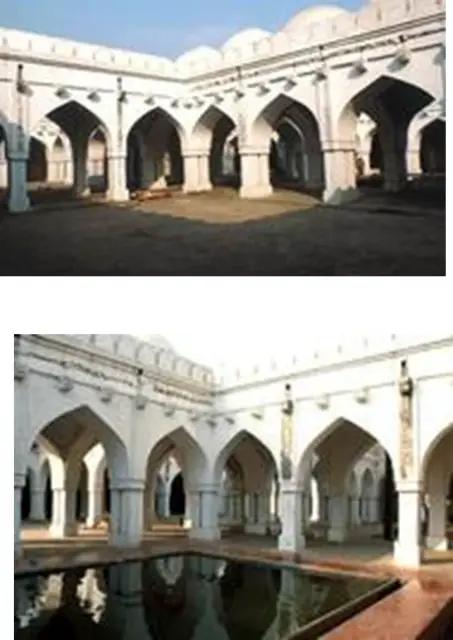
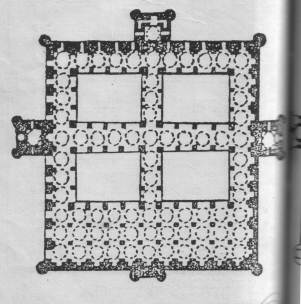
plan of masjid
…KALAN MASJID, SHAHJAHANABAD
A characteristic and favourable specimen of the architecture of this age is the kalan Masjid or Black Mosque which is situated inside the present city, at a short distance from the Turkman Gate
It is built over a platform or basement extra-ordinarily high, so much so, that the stairway leading to the mosque contains 32 stairs. The entrance is on the east side and it `is flanked by tapering turrets and the corners of the mosque have ,conical bastions which are characteristic features of the architecture of this age. The whole is enclosed by an outer wall 5′ (1.52 m,) thick which forms an oblong block of building 140′ (42.66 M.) in length by 120′ (36.57 M.) in breadth. It consists of two storeys is 28′ (8.53 M) in height consisting of a number of small double apartments. The upper storey to the level of- the battlements is 38′ (11.58 M) high making a total height of 66′ (20.11 M). The whole composition gives the appearance of a fortress, imposing and gigantic lowering over its surroundings
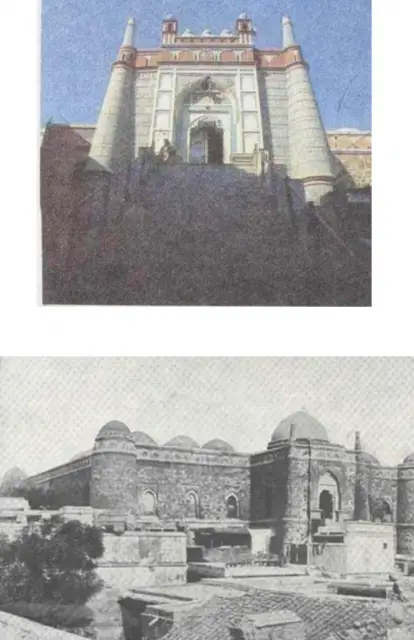
The entrance half of the mosque consists of a rectangular open court around a central pool, with arcades of domed bays resting on huge square stone piers on three sides. The sancluary too has a five arched face.,It is three airles deep, compared of square bays, each bay formed of four arches on the four sides, vaults in the phase of transition and each one individually covered by a cupola, being no other dome on the superstructure which thus wholly consists of cluster pf these cupolas. The arches are protected by a rotating chhajja towards the court. The western wall is of rubble and mortar, plastered over. Mimbar has six steps instead of the usual three. The prayer chamber is divided into fifteen domed bays and has five mihrabs. The lower storey became deep arched niches, generous enough in size to be put to use either as living rooms on shops or even dormitories for pilgrims or festive occasions.
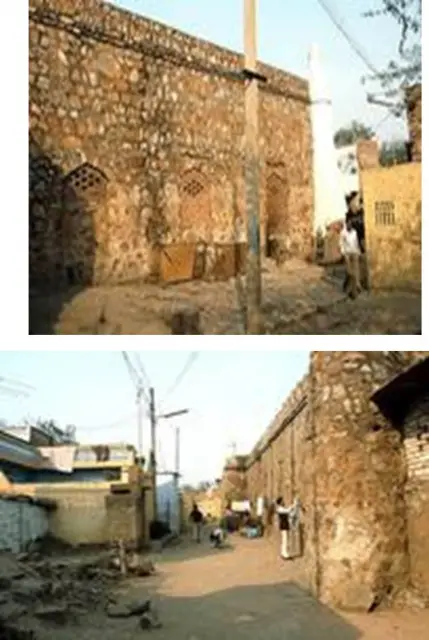
Few characteristics like low domes, sloping minarets and chhajjas of the mosque reflect the typical Tughlaq style of architecture. The courtyard of the mosque is too surrounded by domed cloisters. The entrance of the mosque is from the eastern side and has a high flight of steps that takes directly into the courtyard. Every fourth step is a bit wider than the other steps so that devotees especially women can rest and then move forward. The mosque soon got a new name, Kali meaning black colored by the local population, as initially the outer walls of the mosque were black in color.
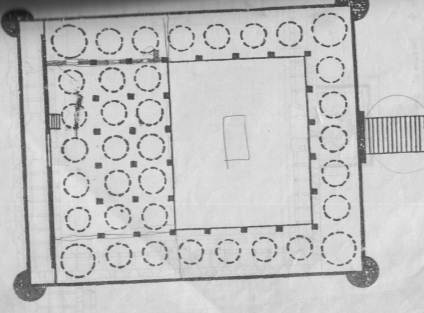
The mosque was comparatively constructed on a large scale with ‘three-aisle deep prayer chamber, pierced by five openings’ and thus was named Kalan, which means big in the Arabic language.
plan of masjid
…JAMI MASJID AT BEGAMPUR
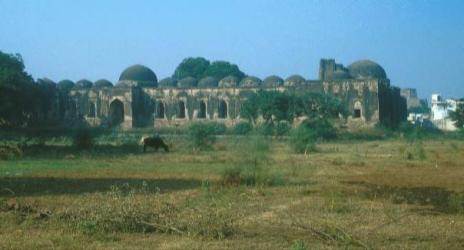
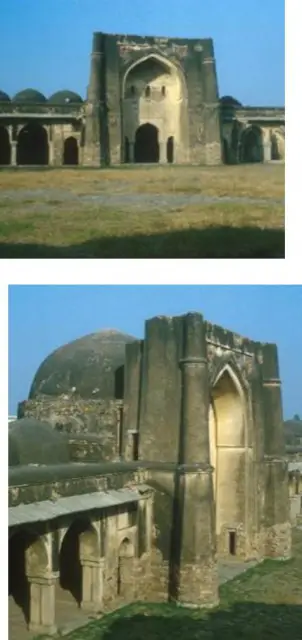
It measures 307’x295′ (93.57xS9:92 m.) with a quadruple measuring 247′ x 223′(75.29. x 67.97 m.). The north and south walls are broken by domed gateways on either side of which is a row of seven windows the south gateway projecting outside and like the northern one has no steps leading upto it. Externally, the last three windows together with a few others in the south wall have the top of the arches in which they are set ornamented with diamond shaped patterns of blue glazed tiles. The west wall is plain but for five mihrab projections outside. The main entrance is through the eastern gateway, which is domed and is reached by a flight of 15 steps. It projects 31′ (9.44 m) outwards from the face of the main wall and has entrance on all four sides. These entrances are set in high recessed archways and above each entrances a panel of red sandstone without any inscription. The gateway-is flanked on either side by 8 windows piercing the entrance wall.
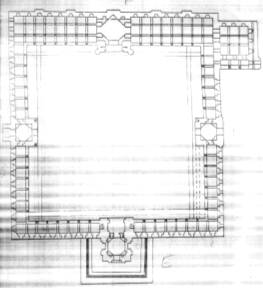
The large central court measuring 75 by 68 Mtrs. is enclosed by arcades on three sides and by a prayer-hall three bays deep and covered by low domes on the west . In the middle of each side are an iwan and dome, here used in the first four iwan plan in Muslim Indian architecture . The arcades are protected by long stone cave (chhajjas) and the bays are covered by low domes on massive square stone pillars. Reflecting an Iranian type, the prayer-hail iwan is framed by two nonfunctional engaged minarets the first polygonal and the upper two circular and tapering like the Qutb Minar. The facade of the prayer-hall is broken by 24 arched openings,, the central one being the highest and flanked by tapering minarets in the Tughluq style.
Projecting off the north end of the prayer wall is a large Royal mosques, three bays square with an impressive stone mihrab. The central compartment of the prayer-hall is surmounted ,by a large dome, while small low domes characteristic of the Tughluq architecture rise on the roof from the central aisle and from the corridors. The mosque’s walls show the typical Tughluq slope and are constructed of ruble masonry covered with a thick coat of durable stucco decorated with small, blue glazed tiles that are in some places still intact and used here for the first time in India’s Muslim architecture are another instance of Iranian influence.
On the whole it is a great conception as to planning and disposal, homogenous and pleasingly proportioned. The pylon was an entirely a new feature which had been unknown in India and as it seems its inspiration came from outside from some allied member of iwan. Though, no doubt it marred the impression of the spherical superstructure, it was magnificently accommodated in be facade of the sanctuary and it was this effect which the architect had in view.
Its emphatic vertical outlines are reinforced by the double columns of the wings and are also at the same time beautifully constructed by the bold horizontal line of the chhajja. Arches have been gorgeously crowned by cupolas; Aisles have deep shadows full of mystery and concern. Firuz’s mosques are quite different in texture and spirit and so are the mosques of Telingani, particularly, such a conspicuous feature as the central pylon is not there in any other mosque of Delhi of the 14th century.
LEGEND OF GUJARI MAHAL……….. HISAR-E-FIROZA
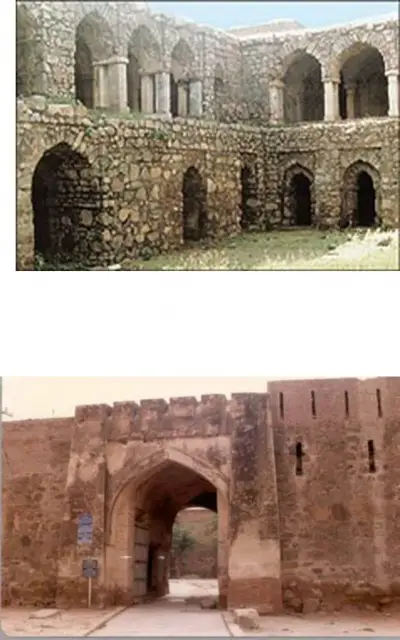
Hisar is situated about 150 km north-westof Delhi. It was founded in 1354 by Firoz Shah Tughlaq before it was a jungle.
According to a legend, Firoz Shah Tughlaq, during one of his hunting trips, came across a Gujjar girl. The Sultan, enthralled by her beauty, married her. The girl refused to accompany the Sultan to Delhi, as she preferred to stay back, the Sultan constructed a palace for her. This palace is now known as Gujari Mahal.
The Sultan was aware of the scarcity of water in the area but he was determined to develop a beautiful city there. As no city can be developed without the availability of water, the Sultan drafted a plan for a canal, which was excavated by 1356. As the canal was filled with the Yamuna water, it was subsequently known as the Western Yamuna Canal.
Earlier the area was known as Hisar-e-Firoza (the fort of Firoz). At present, there are no traces of any monuments of that period, except for the ruins of Gujari Mahal.
The Gujari Mahal is a living monument. This is a complex palace comprising the royal residence of the Gujjar girl and the Sultan, Shahi Darwaza, Diwan-e-Aam, the Baradari with three tehkhanas (underground apartments), a hammam, a mosque and a pillar
LAT KI MAJSID….HISSAR
Within the complex, there is a mosque called Lat Ki Masjid. It is one of the most beautiful mosques built by Firoz Shah. It has a distinguishing pillar and a square chamber. Unlike the usual mosques, it is L-shaped. It also has a pillar that bears the genealogy of the Tughlaq kings.
The mosque is built partly of red and buff sandstone and partly of rubble masonry having thick plaster. Stone pillars showing floral and geometrical designs, extricated from destroyed Hindu temples, support the main arched openings. Its hall 80×21′ having 40 pillars The main prayer-hall has nine bays consisting of arches supported on pillars. It has a carved ‘qibla’ and a pulpit on the wall in the west. Within the courtyard in the northeast, there is a ‘Lat’ (pillar) after which the mosque is named. The ‘Lat’, made of sandstone, is a part of an Asokan pillar. Behind the laat, stands beautiful domed building having a square chamber showing moulded and panelled decorations in red sandstone
.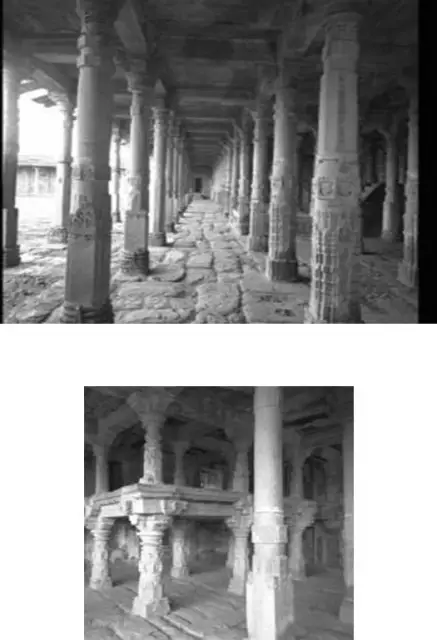

THE CITY …JAUNPUR
Karar Fort, built in 1360 by Sultan Firoz Shah Tughlaq with materials brou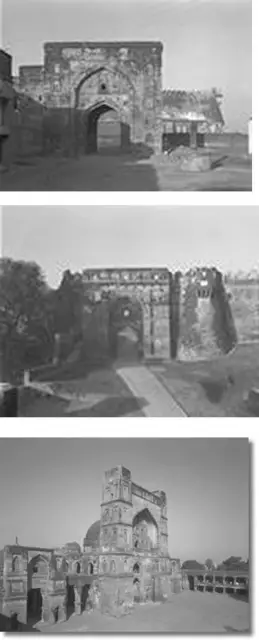 ght in from the palace and temples of the Rathore kings of Kannauj. With the advent of Sharqis, the fortifications were further strengthened and numerous royal edifices added, but only to be reduced to rubble by the Lodis a century later . The fort still offers a few interesting monuments together with the eastern gateway that has been salvaged along with a portion of the fort wall.
ght in from the palace and temples of the Rathore kings of Kannauj. With the advent of Sharqis, the fortifications were further strengthened and numerous royal edifices added, but only to be reduced to rubble by the Lodis a century later . The fort still offers a few interesting monuments together with the eastern gateway that has been salvaged along with a portion of the fort wall.
The Atala Masjid Constructed by Shams ad-Din Ibrdhim on the site of the Hindu temple, Atala Devi, and on foundations prepared by Firoz Shah Tughluq
The Sharqi mosque tapering minarets, battered sides of the propylons, stucco decoration, archand beam openings, and low four-cenfred arches with decorative fringes all derived from examples of Tughlaq mosques in Delhi and, perhaps built by craftsmen fleeins Delhi fbr Life and vzork.
The pylon at the Beghumpuri Masjid in Delhi which seems to have inspired the Jaunpur architect is comparatively a modest
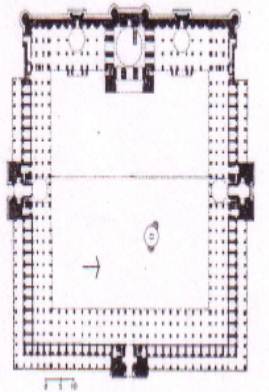
Plan of atala majsid
MATERIAL OF CONSTRUCTION…………IN THE FIROZIAN TIMES
During the long reign of thirty-seven years FIROZ SHAH was responsible for a very large number of important building projects, all produced in a style peculiarly his own.

This style is sufficiently dissimilar from anything appearing previously, that before these building are described some explanation of their deviation from the normal course of development seems called for. The differences in the architectural character of the creations of the Firozian period are fundamental, and imply the birth of a new order of ideas, as they are a reflection of the conditions that prevailed at the seat of the government at this particular juncture.
The economic position was such that Firoz, when he found himself in power even with the best of intentions could only satisfy his structural ambitions by means of buildings composed of inexpensive materials and in a plain but serviceable style.
A CITY PALETTE DEVOID OF COLOURS
Architecture produced on these terms resolves itself into a somewhat dull and featureless form of expression, a scheme of somber monochromes and half-tones, although it is true some of the lack of effect now observable due to long centuries of weathering.
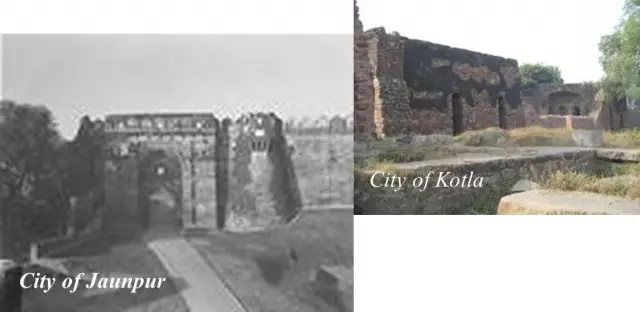
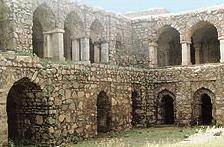
For in its prime a certain surface finish was obtained by means of color wash, since entirely abraded, but even when its new could not have been inspiring, as its outward aspect was almost entirely one of plain white.
city of hisar
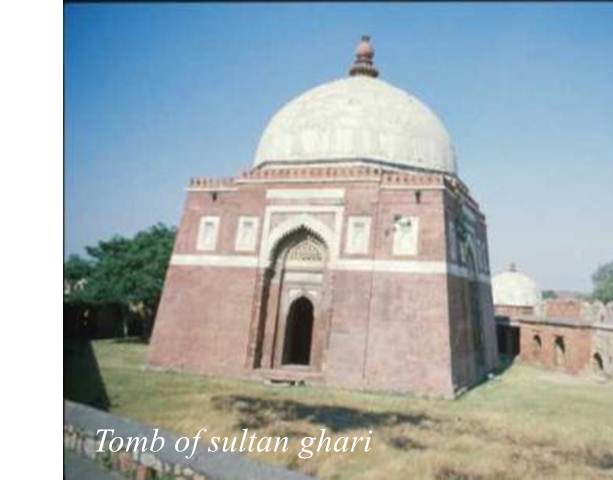
tomb of sultan ghari
…..UNIMISTAKABLY ECONOMIC ARCHITECTURE
It is form of architecture that cannot be mistaken.
In place of the finely coursed and well-finished sandstone ashlar, a very- different order, consisting of random rubble work was used, its untrimmed surfaces being coated with a substantial layer of cement
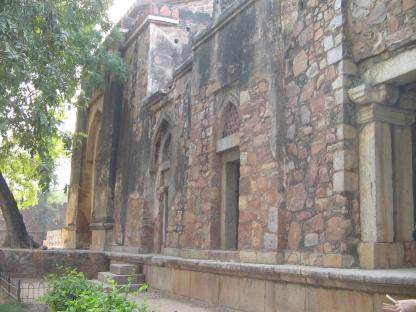
Hauz khas tomb
In certain parts of the building such essentially structural features as lintels, doorposts, pillars and the like, were formed of roughly dressed monoliths, and in the rare instances where decoration was applied, it was not carved in stone but molded in plaster.
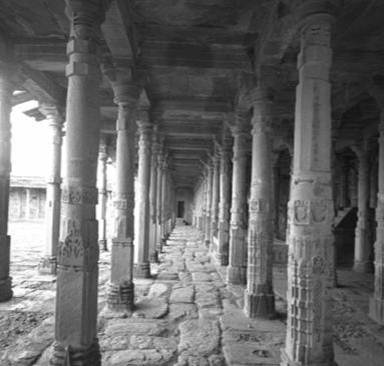
Lat ki masjid
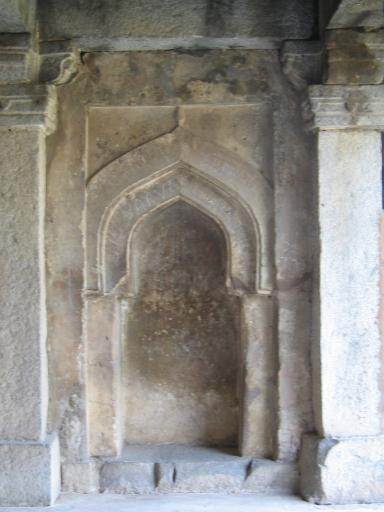
Haus khas complex
…THE CHANGING SYMBOLIC ARCHITECTONICS
Construction methodology employed by the Firozian builders naturally reacted on the character of the architectural style.
Additional strength and stability was assured by building certain portions thicker at the base than at the top, an experience which gives the illusion of greater power, although no such angle of batter is really structurally necessary.
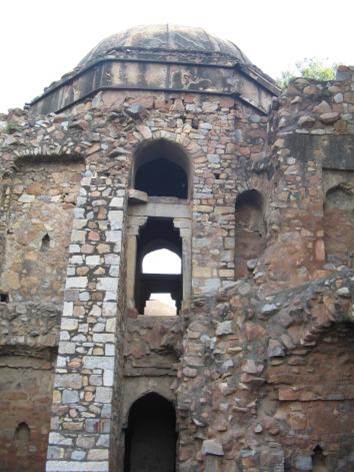
This effect of slope is emphasized in many of the examples by the attachment of tapering turreted buttresses at the quoins, and by pro-jecting conical bastion-like towers crowned with low domes from the four comers of the building. The four pillars at the corners enclose the volume in which the structure spans.
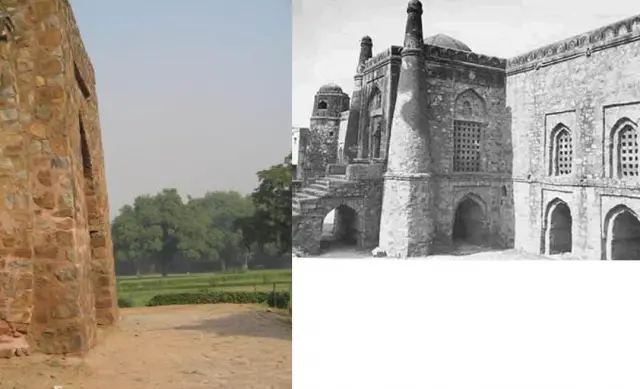
….MATERIALS AND WORKMANSHIP
Under the Khiljis architecture had begun to acquire a standard proportion of mass, grace and ornament and a preference for an appropriate use of red color to relieve the grey drab surfaces. But with the puritanical Tughluq the order changed.
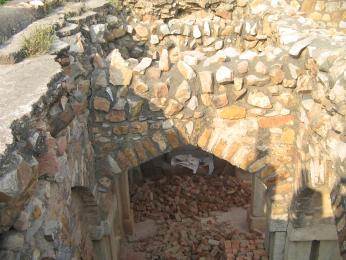
An important advantage enjoyed by Tughluq architects was that even the biggest mosques and tombs were usually erected during an amazingly short time. Tughtuq architects were proud of their ability to build quickly.
Use of tessellated pavement (farsh-i-tarshib) has also been recorded for the west wall of the college of sultan Alla-ud-Din. Use of dug up earth for embankment of the ditch and side walls in Hisar-firoz is also recorded Thick walls of mud or bricks may have been ,borrowed by the ,Tughluq from Sind, Punjab or even Afghanistan, where mud and brick were in use.”
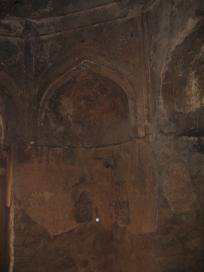
While sandstone had indeed been used interspersed white-marble and burnt brick, undressed stones and rubble formed the main materials in construction. Gach (cement) and strong quick lime and burnt bricks have been used variously in Hauz Khas,’ bands of channels and in Hisar Firoz respectively, and hewn-stone stair-case in respect of Firoz Shah’s repair of the tomb of Sultan’s Ghari has been used
…..RESOURCES THAT CREATED THE DIFFERENCE

We should now consider the resources, by way of building materials, that were at the disposal of the patrons of this new order. Delhi being located at the
terminal outlier of the Aravalli hill chain, abounds in ridges of low hillocks of a -other metamorphosed-variety of quartzite which does not fracture well, is indeed found in massive blocks and laminated lumps; ‘and is an all too poor a material for Working for decoration or detailed carving. Without anticipating this special phase of the Tughluqs in so far as Islamic architecture around Delhi goes, we may just Say that these and many other constructions of that period any even the earlier and
Later ones were built of Delhi quartzite.

…..HENCE THE CHRONICLE NARRATES

Firozian attempt to expand the activity, consistent with the skills and resources available was certainly not one to be caviled at , even for its originality this was the simple and austere phase of architecture with an increasing building activities.
Although as a ruler, Firoz Shah Tughlaq might have failed, but he would always be remembered as a great builder who cared for and considered the Indian ness of the land he was building. Hindus learnt the construction of making domes and arches, although during this phase domes were more of experimental structurally.
- The buildings were constructed of with shapeless rough rubbles, coated with thick plaster ,which was incised and decorated with geometrical patterns.
- Architectural features saw a fusion of the Indian and Islamic worlds. Broadly speaking the style of the period is heavy, massive, simple and austere, with sloping walls, squinch arches, triangular pendentives for supporting low domes, battlement necking or support at external angles of the buildings.

- But the noteworthy of this period is their fine proportions and balance, besides, they are expressive of strength and determination.
- Four-folded gardens, called the charbagh became an indispensable part of this new typology of buildings.
- The Indian non-muslim building tradition such as the the chattri, blocky pillars and capital, the heavy stone railings and balustrade, and the chhajjas or eaves. Their absorption into muslin building styles was essential to the creation of Indo-Islamic Architecture.

- The mosque architecture under Tughlaqs saw many changes:
Begampuri And Lat-ki-masid with courtyard with arcades on the sides of rubble masonary.

Jami masid at Kotla andHhauz Khas with high plinth and west walls.
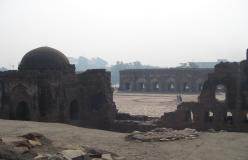
The co-axial mosque for example the Khriki And The Kalan Masjid
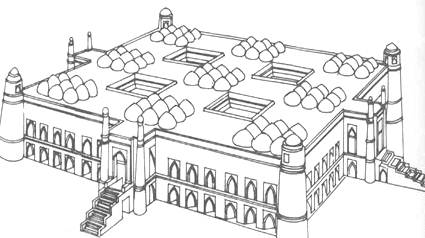
It is on of the characteristic that Firoz Shah buildings were functional, which is clearly witnessed in the pyramidal structure of Kushk-i-Shikar, Kotla, on which he erected the Ashokan Lat,so that the dignity and strenght is amparted to the construction and non-functional ormenataiona has been discouraged.
Under Tughlaqs a definite symbolism of architectural form seems to have been followed.
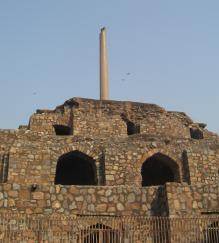
……AND THE SAGA CONTINUES
During Firoz Shah’s reign, although maximum number of building projects was undertaken, none of the structures were so memorable enough to be written in the golden annals of history. There was more of quantity and very less of quality.
Architecture produced on these terms resolves itself into a somewhat dull and featureless form of expression, a scheme of somber monochromes and half-tones, although it is true some of the lack of effect now observable due to long centuries of weathering
Tughluq palaces represent an impressive diversity of type and their functional variety indicates the increasing sophistication in the Muslim World. They seem to have been consciously employed as nucleuses for new urban areas, and they were thus the most important elements in the enormous city projects undertaken. Size of Tughluq palace complexes can be understood as a response to the increasing bureaucratic centralization of the Tughluq state and to the massive immigration of Muslims into India from the west. These cities and palaces in fact became the inspiration of the Mughal architecture few centuries later…..

Leave a Reply
You must be logged in to post a comment.